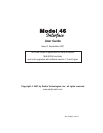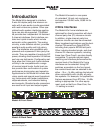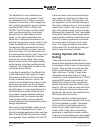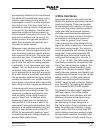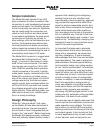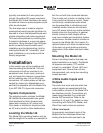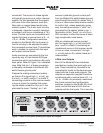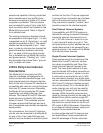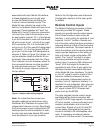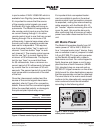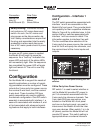
Model 46 User Guide Issue 2, September 2007
Studio Technologies, Inc. Page 9
Simple Installation
The Model 46 uses standard 3-pin XLR-
type connectors to allow convenient inter-
connection in most broadcast and general
audio environments. For flexibility, access
to the 2-wire party-line intercom interfaces
can be made using the connectors pro-
vided on both the front and back panels.
In permanent installations the back-panel
connectors will typically be utilized. In
other settings, such as field television pro-
duction, front-panel-access allows inter-
com belt packs to be rapidly connected,
without requiring access to the inside of a
rack enclosure or necessitating the use of
a secondary input/output (I/O) panel.
The Model 46 is housed in a rugged steel
enclosure that is designed to be “road
tough.” It mounts in one space of a stan-
dard 19-inch rack enclosure. The mains
input source can range from 100 to 240
volts, 50/60 Hz allowing direct operation
virtually anywhere in the world. A switch-
mode power supply, contained within the
Model 46’s enclosure, provides conver-
sion of the mains input power into the DC
voltage required by the intercom power
supply circuits. Also contained within the
unit is a DC-to-DC converter that creates
the voltages required by the analog and
digital circuitry. These efficient power sup-
plies help to ensure cool, reliable opera-
tion in a variety of settings.
Design Philosophy
While the “bits and pieces” that make
up the Model 46 have been described in
conventional terms, the real strength of
the unit rests in how it integrates and per-
forms in the “real world.” Before beginning
the Model 46’s design process, conversa-
tions with industry experts quickly made it
apparent that installing and configuring
existing 2-wire-to-4-wire interface units
was invariably a time-consuming, aggravat-
ing process that required the talent of an
expert to achieve reasonable results. And
even under those constraints the resulting
audio performance was often mediocre.
Any new design had to look at the applica-
tion in a different way. This led to the over-
riding Model 46 design goal: create a “new
breed of cat,” fundamentally changing how
broadcast 2-wire-to-4-wire interface equip-
ment fit into actual applications.
An important first step was to eliminate
the requirement that a senior technician,
along with a screwdriver, be present dur-
ing every installation. (It was universally
acknowledged that their time can be better
spent elsewhere!) The need to adjust trim
potentiometers, fabricate special cabling
and connector straps, use nulling earpiec-
es, etc. had to be eliminated. For example,
in virtually all instances, input and output
levels fall within just a few dB of their nomi-
nal values and, as such, could be support-
ed with a limited number of configurable
choices. In addition, it was acknowledged
that in this application analog audio cir-
cuitry was capable of providing excellent
audio performance, but that the required
manual nulling process was operation-
ally taxing. By adding digital control to the
analog circuitry, automatic nulling couldbe
performed—the best of both worlds!
The next step was to identify resources that
would improve the installation process and
make operation more reliable. This led to
the inclusion of multiple LED level meters,
allowing continuous monitoring of the input
and output signals. It also turned out that
in many applications only a small number
of user devices, such as belt packs, are



